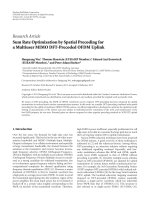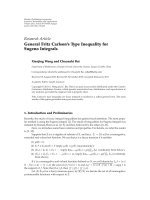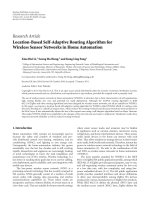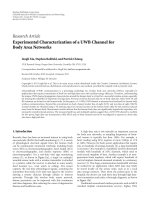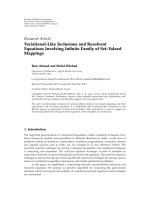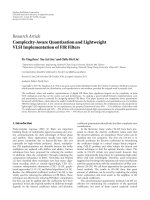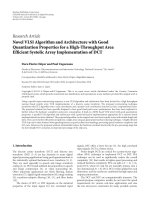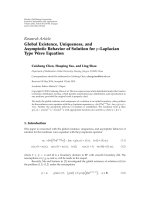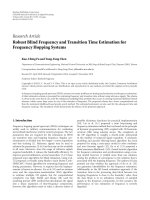Báo cáo hóa học: "Research Article Joint Video Summarization and Transmission Adaptation for Energy-Efficient Wireless Video Streaming" pptx
Bạn đang xem bản rút gọn của tài liệu. Xem và tải ngay bản đầy đủ của tài liệu tại đây (922.83 KB, 11 trang )
Hindawi Publishing Corporation
EURASIP Journal on Advances in Signal Processing
Volume 2008, Article ID 657032, 11 pages
doi:10.1155/2008/657032
Research Article
Joint Video Summarization and Transmission Adaptation for
Energy-Efficient Wireless Video Streaming
Zhu Li,
1
Fan Zhai,
2
and Aggelos K. Katsaggelos
3
1
Department of Computing, Hong Kong Polytechnic University, Kowloon, Hong Kong
2
DSP Systems, ASP, Texas Instruments Inc., Dallas, TX 75243, USA
3
Department of Electrical Engineering & Computer Science (EECS), Northwestern University, Evanston, IL 60208, USA
Correspondence should be addressed to Zhu Li,
Received 13 October 2007; Accepted 25 February 2008
Recommended by Jianfei Cai
The deployment of the higher data rate wireless infrastructure systems and the emerging convergence of voice, video, and data
services have been driving various modern multimedia applications, such as video streaming and mobile TV. However, the greatest
challenge for video transmission over an uplink multiaccess wireless channel is the limited channel bandwidth and battery energy
of a mobile device. In this paper, we pursue an energy-efficient video communication solution through joint video summarization
and transmission adaptation over a slow fading wireless channel. Video summarization, coding and modulation schemes, and
packet transmission are optimally adapted to the unique packet arrival and delay characteristics of the video summaries. In
addition to the optimal solution, we also propose a heuristic solution that has close-to-optimal performance. Operational energy
efficiency versus video distortion performance is characterized under a summarization setting. Simulation results demonstrate the
advantage of the proposed scheme in energy efficiency and video transmission quality.
Copyright © 2008 Zhu Li et al. This is an open access article distributed under the Creative Commons Attribution License, which
permits unrestricted use, distribution, and reproduction in any medium, provided the original work is properly cited.
1. INTRODUCTION
The rapid increase in channel bandwidth brought about
by new technologies such as the present third-generation
(3G), the emerging fourth-generation (4G) wireless systems,
and the IEEE 802.11 WLAN standards is enabling video
streaming in personal communications and driving a wide
range of modern multimedia applications such as video
telephony and mobile TV. However, transmitting video over
wireless channels from mobile devices still faces some unique
challenges. Due to the shadowing and multipath effect,
the channel gain varies over time, which makes reliable
signaling difficult. On the other hand, a major limitation in
any wireless system is the fact that mobile devices typically
depend on a battery with a limited energy supply. Such
a limitation is especially of concern because of the high
energy consumption rate for encoding and transmitting
video bit streams. Therefore, how to achieve reliable video
communications over a fading channel with energy efficiency
is crucial for the wide deployment of wireless video-based
applications.
Energy-efficient wireless communications is a widely
studied topic. For example, a simple scheme is to put the
device into sleep mode when not in use, as in [1, 2]. Although
the energy consumption on circuits is being driven down, as
the VLSI design and integrated circuit (IC) manufacturing
technologies advance, the communication energy cost is
lower bounded by information theory results. In [3], the
fundamental tradeoff between average power and delay con-
straint in communication over fading channels is explored
andcharacterized.In[4], optimal power control schemes for
communication over fading channels are developed. In [5,
6], optimal offline and near optimal online packet scheduling
algorithms are developed to directly minimize energy usage
in transmitting a given amount of information over fading
channels with certain delay constraints.
Video streaming applications typically have different
quality of service (QoS) requirements with respect to packet
loss probability and delay constraints, which differenti-
ate them from traditional data transmission applications.
Approaches of cross-layer optimization of video source
coding/adaptation and communication decisions have been
2 EURASIP Journal on Advances in Signal Processing
widely adopted. Taking advantage of the specific characteris-
tics of video source and jointly adapting video source coding
decisions with transmission power, modulation and coding
schemes can achieve substantial energy efficiency compared
with nonadaptive transmission schemes. Examples of this
type of work are reported in [7–11]. In those studies, source-
coding controls are mostly based on frame and/or mac-
roblock (MB) level coding mode and parameter decisions.
When both bandwidth and energy are severely limited for
video streaming, sending a video sequence over with severe
distortion is not desirable. Instead, we consider joint video
summarization and transmission approaches to achieve the
required energy efficiency. Video summarization is a video
adaptation technique that selects a subset of video frames
from the original video sequence based on some criterion,
e.g., some newly defined frame loss distortion metric [12],
specified by the user. It generates a shorter yet visually more
pleasing sequence than traditional technologies that usually
focus on the optimization of quantization parameters (QP)
[12], which can have serious artifacts at reconstruction at
very low bit rates.
Video summarization may be required when a system
is operating under limited bandwidth conditions, or under
tight constraints in viewing time or storage capacity. For
example, for a remote surveillance application in which video
must be recorded over long lengths of time, a shorter version
of the original video sequence may be desirable when the
viewing time is a constraint. Video summarization is also
needed when important video segments must be transmitted
to a base station in real time in order to be viewed by a human
operator. Examples of the video summarization and related
shot segmentation work can be found in [13–18], where a
video sequence is segmented into video shots, and then one
or multiple key frames per shot are selected based on certain
criterion for the summary.
In this work, we consider the application of video
summarization over wireless channels. In particular, we
consider using the scheme of video summarization together
with other adaptations including transmission power and
modulations to deal with problems in uplink wireless video
transmission arising from the severe limitation in both
bandwidth and transmission energy. Since the summa-
rization process inevitably introduces distortion, and the
summarization “rate” is related to the conciseness of the
summary, we formulated the summarization problem as a
rate-distortion optimization problem in [12], and developed
an optimal solution based on dynamic programming. We
extended the formulation to deal with the situation where
bitrateisusedassummarizationratein[19]. In [20, 21],
we formulated the energy-efficient video summarization
and transmission problem as an energy-summarization
distortion optimization problem; the solution of which is
found through jointly optimizing the summarization and
transmission parameters/decisions to achieve the operational
optimality in energy efficiency. In this paper, we further
extend the work in [20, 21] to consider the maximum frame
drop distortion case for energy-efficient streaming. We also
propose a heuristic solution, which is a greedy method that
approximates well the performance of the optimal solutions.
The rest of the paper is organized as follows. In Section 2,
we describe the assumptions on the communication over
fading wireless channels and formulate the problem as
an energy-summarization distortion optimization problem.
In Section 3, we develop an optimal solution based on
Lagrangian relaxation and dynamic programming, as well
as a heuristic solution. In Section 4, we present simulation
results. Finally, in Section 5 we draw conclusions and discuss
the future work in this area.
2. ASSUMPTIONS AND PROBLEM FORMULATION
In this section, we describe the channel model used in this
work, carry out delay analysis for video summary packets,
and provide the problem formulations.
2.1. Wireless channel models and assumptions
In this work, we assume that the wireless channel can be
modeled as a band-limited, additive white Gaussian noise
(AWGN) channel with discrete time, and slow block fading.
The output y
k
is a function of the input x
k
as
y
k
=
h
k
x
k
+ n
k
,(1)
where h
k
is the channel gain for time slot k and n
k
is the
additive Gaussian noise with power spectrum density N.We
assume that the channel gain stays constant for time T
c
,
the channel coherent time, and that the symbol duration T
s
satisfies T
s
T
c
, thus the channel is slow fading and there
are many channel uses during each time slot. The variation
of the channel state is modeled as a finite state Markov
channel (FSMC) [22], which has a finite set of possible states,
H
={h
1
, h
2
, , h
m
},andtransitionseveryT
c
second with
probability given by the transition probability matrix A
=
|
a
ij
|,wherea
ij
= Prob {transition from h
i
to h
j
}.
To reliably send R information bits over the fading
channel in one channel use, the minimum power needed
with optimal coding is given as [23]
P
= N
2
2R
−1
/h,(2)
where h represents the channel gain. Similarly to the analysis
in [5], let x
= 1/R be the number of transmissions needed
to send one bit over the channel; we can characterize the
energy-delay tradeoff as E
b
, energy per bit as a function of
x as
E
b
(x,h) = xP = xN
2
2/x
−1
/h. (3)
Examples of the energy efficiency functions with different
fading states are shown in Figure 1. The range of x in Figure 1
corresponds to the received signal-to-noise tatio (SNR)
of 2.0 dB to 20 dB, a typical operating range for wireless
communication. To send a data packet with B bits and
deadline τ, assuming τ
T
c
, the number of transmissions
available is equal to 2Wτ,whereW is the signaling rate. Then
Zhu Li et al. 3
0
5
10
15
20
25
30
35
E
b
(mJ/bit)
0.20.40.60.811.21.41.61.822.2
x
h
0
= 1
h
1
= 0.9
h
2
= 0.6
Energy efficiency E
b
(x; h), N = 1 mJ/channel use
Figure 1: Energy-efficiency over fading channels.
the expected energy cost will be
E(B, τ)
= E
H
E
b
(2Wτ/B, h)B | A, H, h
0
. (4)
In (4), the expectation E
H
is with respect to all possible
channel states, which are governed by an FSMC specified
by the state set H, the transition probability matrix A,and
the initial state h
0
. The function in (4) can be implemented
as a lookup table for a given channel model in simulations.
A closed form solution may also be possible, under some
optimal coding and packet scheduling assumptions. More
details for a 2-state FSMC channel analysis can be found in
the appendix.
2.2. Summarization and packet delay
constraint analysis
Let a video sequence of n frames be denoted by V
=
{
f
0
, f
1
, , f
n−1
} and its video summary of m frames by
S
={f
l
0
, f
l
1
, , f
l
m−1
}. Obviously, the video summarization
process has an implicit constraint that 0
≤ l
0
<l
1
<
··· <l
m−1
≤ n − 1. Let the reconstructed sequence V
S
=
{
f
0
, f
1
, , f
n−1
} be obtained by substituting missing frames
with the most recent frame that is in the summary S, that is,
f
k
= f
i=max(l): s.t.l∈{l
0
, l
1
, , l
m−1
}, i≤k
. Let the summarization rate
be
R(S)
=
m
n
,(5)
taking values in
{1/n,2/n, , n/n}. The summarization
distortion can be computed as the average frame distor-
tion between the original sequence and the reconstructed
sequence from the summary
D(S)
=
1
n
n−1
k=0
d
f
k
, f
k
,(6)
where d( f
k
, f
k
) is the distortion of the reconstructed frame
f
k
and n is the number of frames in the video sequence.
Various distortion metrics can be utilized here to capture the
impact of frame-loss-induced distortion, d( f
k
, f
k
). In this
work, we use the Euclidean distance of scaled frames in PCA
space, as discussed in [12]. This is an effective metric that
matches the perception of frame losses well.
In video summarization studies [24], we also found that
in addition to the average frame loss distortion metric, the
maximum frame loss distortion-based metric is also very
effective in matching the subjective perception, especially the
jerkiness in playback. Therefore, the video summarization
distortion can also be defined as
D(S)
= max
k
d
f
k
, f
k
. (7)
The loss of frames in high activity segments of video
sequence will typically result in a large D(S) in this case.
The average (l
2
) and maximum (l
∞
)metricsforvideo
summarization compliment each other in characterizing the
distortion.
For the encoding of the video summary frames, we
assume a constant Peak SNR (PSNR) or QP coding strategy,
with frame bit budget B
l
j
givenbysomerateprofilersee,
for example, [25]. Packets from different summary frames
have different delay tolerances. Without loss of generality,
we assume that the first frame of the original sequence,
f
0
, is always selected for the summary and intracoded with
some B
0
bits. The delay tolerance τ
0
is determined by how
much initial streaming delay is allowed in an application. For
packets generated by the summary frame f
l
j
,withl
j
> 0, if
the previous summary frame f
l
j−1
is decoded at time t
j−1
,
then the packet needs to arrive by the time t
j
= t
j−1
+
(l
j
− l
j−1
)/F,whereF is the frame rate of the original video
sequence. Therefore, the delay tolerance for frame f
l
j
is τ
l
j
=
(l
j
−l
j−1
)/F. This is a simplified delay model, not accounting
for minor variations in frame encoding and other delays. The
energy cost to transmit a summary S of m frames is therefore
given by
E(S)
=
m−1
k=0
E
B
l
k
, τ
l
k
= E
B
0
, τ
0
+
m−1
k=1
E
B
l
k
, τ
l
k
,(8)
where B
l
k
is the number of bits needed to encode summary
frame f
l
k
,andτ
l
k
is the delay tolerance for frame f
l
k
.
There are tradeoffs between the summary transmission
energy cost, E(S), and the summarization distortion, D(S).
The more frames selected into the summary, the smaller
the summarization distortion. On the other hand, the more
frames in the summary, the more bits needed to be spent
in encoding the frames, and the packet arrival pattern gets
more dense, which can be translated into higher bit rate
and smaller delay tolerance. The transmission of more bits
with more stringent deadline can incur higher transmission
energy cost.
In the next subsection, we will characterize the relation-
ship between the summarization distortion and energy cost,
and formulate the energy-efficient video summarization
4 EURASIP Journal on Advances in Signal Processing
and transmission problem as an energy-distortion (E-D)
optimization problem.
2.3. Energy-efficient summarization formulations
The energy-efficient summarization problem can be formu-
lated as a constrained optimization problem. For a given
constraint on the summarization distortion, we need to
find the optimal summary that minimizes the transmission
energy cost, while satisfying the distortion constraint, D
max
.
That is, the Minimizing Energy Optimal Summarization
(MEOS) formulation is given by
S
∗
= arg min
S
E(S), s.t.D(S) ≤ D
max
. (9)
We can also formulate the energy efficiency problem as
a Minimizing Distortion Optimal Summarization (MDOS)
problem. That is, for a given energy constraint, E
max
,we
want to find the optimal summary that minimizes the
summarization distortion:
S
∗
= arg min
S
D(S), s.t.E(S) ≤ E
max
. (10)
The optimal solutions to the formulations in (9)and(10)
can be achieved through Dynamic Programming (DP) for
the maximum frame loss distortion case in (7), by exploiting
the structure of the summarization problem. As for the
average distortion metric case in (6), a convex hull optimal
solution can be found via Lagrangian relaxation and DP,
which are discussed in more detail in the next section.
3. SOLUTION ALGORITHMS
Solving the constrained problems in (9)and(10) directly
is usually difficult due to the complicated dependencies
and large searching space for the operating parameters.
For the average distortion case, we introduce the Lagrange
multiplier relaxation to convert the original problem into
an unconstrained problem. The solution to the original
problem can then be found by solving the resulting uncon-
strained problem with the appropriate Lagrange multiplier
that satisfies the constraint. This gradient-based approach
has been widely used in solving a number of coding and
resource allocation problems in video/image compression [8,
26]. For the maximum distortion case, a direct DP solution
can provide us with the optimal solution at polynomial
computational complexity. Finally, we introduce a heuristic
algorithm that approximates the E-D performance of the
optimal solutions at a fraction of the computational cost.
3.1. Average distortion problems
Considering the MEOS formulation with the average distor-
tion metric in (4), by introducing the Lagrange multiplier,
the relaxed problem is given by
S
∗
(λ) = arg min
S
E(S)+ λD(S)
, (11)
0
1
2
3
4
5
Frame k
11.522.533.54 4.555.56
Epoch t
J
0
1
=11.56
J
1
2
=19.69
J
2
2
=16.02 J
2
3
=16.86
J
3
2
=18.09 J
3
3
=18.45 J
3
4
=19.57
J
4
2
=14.49 J
4
3
=14.07 J
4
4
=14.87 J
4
5
=15.98
J
5
2
=11.56 J
5
3
=14.49 J
5
4
=14.07 J
5
5
=14.87 J
5
6
=15.98
λ
= 1e −004
Figure 2: An example of DP trellis for the average distortion
minimization problem.
in which the optimal solution S
∗
becomes a function of λ.
From [27], we know that by varying λ from zero to infinity,
we sweep the convex hull of the operational E-D function
E(D(S
∗
(λ))), which is also monotonic with respect to λ.
Therefore, a bisection search algorithm on λ can give us
the optimal solution within a convex hull approximation.
In real-world applications, the E-D operational point sets
are typically convex, and the optimal solution can indeed be
found by the algorithm described above.
Solving the relaxed problem in (11) by exhaustive
search is not feasible in practice, due to its exponential
computational complexity. Instead, we observe that there
are built-in recursive structures that can be exploited for
an efficient dynamic programming solution of the relaxed
problem with polynomial computational complexity.
First, let us introduce a notation on segment distortion
introduced by missing frames between summary frame l
t
and
l
t+1
, which is given by
G
l
t+1
l
t
=
l
t+1
−1
k=l
t
d
f
l
t
, f
k
. (12)
Let the state ofavideosummaryhavet frames, and the last
frame f
k
be the minimum of the relaxed objective function
given by
J
k
t
(λ) = min
S:s.t. |S|=t,l
t−1
=k
D(S)+λE(S)
=
min
l
1
,l
2
, ,l
t−2
G
l
1
0
+G
l
2
l
1
+ ···G
k
l
t−2
+G
n
k
+ λ
t−1
k=0
E
B
l
k
, τ
l
k
,
(13)
where
|S| denotes the number of frames in S. Note that
l
0
= 0, as we assume the first frame is always selected. The
Zhu Li et al. 5
minimization process in (11) has the following recursion:
J
k
t+1
(λ)
= min
S:s.t. |S|=t+1, l
t
=k
D(S)+λE(S)
=
min
l
1
,l
2
, ,l
t−1
G
l
1
0
+ G
l
2
l
1
···+ G
k
l
t−1
+ G
n
k
+ λ
E
B
0
, τ
0
+ E
B
l
1
,
l
1
−0
/F
+ ···+ E
B
l
t−1
,
l
t−1
−l
t−2
/F
+ E
B
k
,
k −l
t−1
/F
=
min
l
1
,l
2
, ,l
t−1
⎧
⎪
⎪
⎪
⎪
⎨
⎪
⎪
⎪
⎪
⎩
G
l
1
0
+ G
l
2
l
1
···+ G
l
t−1
l
t−2
+ G
n
l
t−1
D
l
t
−1
t
−G
n
l
t−1
+ G
k
l
t−1
+ G
n
k
+ λ
⎡
⎢
⎢
⎢
⎣
E
B
0
, τ
0
+ E
B
l
1
,
l
1
−0
/F
E
l
t
−1
t
+ ···+ E
B
l
t−1
,
l
t−1
−l
t−2
/F
E
l
t
−1
t
+ E
B
k
,
k −l
t−1
/F
⎤
⎥
⎥
⎥
⎦
⎫
⎪
⎪
⎪
⎬
⎪
⎪
⎪
⎭
=
min
l
1
,l
2
, ,l
t−1
⎧
⎪
⎪
⎪
⎨
⎪
⎪
⎪
⎩
D
l
t−1
t
+ λE
l
t−1
t
+λE
B
k
,
k−l
t−1
/F
−G
n
l
t−1
+G
k
l
t−1
+G
n
k
e
l
t
−1
,k
⎫
⎪
⎪
⎬
⎪
⎪
⎭
=
min
l
t−1
J
l
t−1
t
(λ)+e
l
t−1
,k
.
(14)
The recursion has the initial condition given by
J
0
1
(λ) = G
n
0
+ λE
B
0
, τ
0
. (15)
The cost of transition is given by the edge cost e
l
t−1
,k
in (14),
which is a function of λ, l
t−1
and k as
e
l
t−1
,k
=
⎧
⎨
⎩
λE
r
k
,
k−l
t−1
/F
−G
n
l
t−1
+G
k
l
t−1
+G
n
k
, intracoding,
λE
r
k,l
t−1
,
k−l
t−1
/F
−
G
n
l
t−1
+G
k
l
t−1
+G
n
k
intercoding,
(16)
where r
k
and r
k,l
t−1
are the estimated bit rates obtained from
a rate profiler (e.g., [25]) to intracode the frame f
k
,and
intercode frame f
k
with backward prediction from frame
f
l
t−1
, respectively. The DP solution starts with the initial node
J
0
1
, and propagates through a trellis with arcs representing
possible transitions. At each node, we compute and store the
optimal incoming arc and the minimum cost. Once all nodes
with the final virtual frame f
n
, {J
n
t
(λ) | t = 1, 2, , n},are
computed, the optimal solution to the relaxed problem in
(11) is found by selecting the minimum cost
S
∗
(λ) = arg min
t
J
n
t
(λ)
, (17)
and backtracking from the resulting final virtual frame nodes
for the optimal solution. This is similar to the Viterbi
algorithm [28]. An example of a trellis for n
= 5and
λ
= 1.0e–4 is shown in Figure 2, where all possible state
transitions are plotted. For each state node, the minimum
incoming cost is plotted as solid line, while other incoming
arcs are plotted as dotted lines. For example, the node J
4
3
is
computed as J
4
3
= min
j∈{1,2,3}
{J
j
2
+ e
j,4
}, and its incoming
arc with the minimum cost is from node J
2
2
. The virtual final
frame nodes are all at the top of the trellis.
The Lagrange multiplier controls the tradeoff between
summarization distortion and the energy cost in transmit-
ting the summarized video frames. By varying the value
of λ and solving the relaxed problem in the inner loop,
we can obtain the optimal solution that minimizes the
transmission energy cost while meeting certain distortion
constraints. Since the operational energy-distortion function
E(D(S
∗
(λ))) is monotonic with respect to λ,afastbisection
search algorithm can be applied to find the optimal λ
∗
,which
results in the tightest bound on the distortion constraint
D
max
, that is, D(S
∗
(λ
∗
)) is the closest to D
max
. The algorithm
can perform even faster by reusing the distortion and energy
cost results that only need to be computed once in the
iteration. The solution to the MEOS formulation can also be
solved in the same fashion.
The complexity of the optimal inner loop solution is
polynomial in frame number n, and the outer loop bisection
search complexity depends on the choice of initial search
window size and location. But overall, for small n<60, the
complexity can be well handled by mobile devices with more
powerful modern processors.
3.2. Maximum distortion problems
When the maximum distortion metric in (6)isused,
the problem has a simpler structure due to less complex
dependencies. Let us consider the MEOS problem first.
The objective here is to minimize the energy cost of
transmitting a segment of the video summary, with the given
constraint on the maximum frame distortion allowed. Unlike
the complicated structures in the average distortion case,
this given distortion constraint can be used to prune the
infeasible edges in the summary state trellis similarly to the
previous case, and then a search and back tracking algorithm
can be derived.
Let us define the summarization distortion for the video
segment between video summary frames l
t
and l
t+1
as
D
l
t+1
l
t
= max
j∈[l
t
, l
t+1
−1]
d
f
l
t
, f
j
. (18)
This is the maximum frame distortion between the previous
summary frame l
t
, and the subsequent missing frames before
6 EURASIP Journal on Advances in Signal Processing
the next summary frame l
t+1
. It is clear that the placement of
summary frames will have a major impact on the resulting
video summary distortion. Generally, the larger the distance
between the two summary frames l
t
and l
t+1
, the larger the
resulting distortion. Where the summary frames are placed
is also important. For example, if the summary frames l
t
and
l
t+1
astride two different video shots, there will be a spike in
the distortion D
l
t+1
l
t
.
A frame loss distortion larger than D
max
is not allowed in
this case; we can reflect this constraint by defining the energy
cost for the segment as
E
l
t+1
l
t
=
⎧
⎨
⎩
E
B
l
t+1
,
l
t+1
−l
t
/F
,ifD
l
t+1
l
t
≤ D
max
,
∞, otherwise.
(19)
With this, any summary frame selections with resulting
segment distortion greater than D
max
are excluded from the
MEOS solution.
For the maximum energy minimization problem, let us
also explore the structure of the energy cost of the optimal
video summary solution ending with frame l
t
:
E
l
t
= min
l
1
,l
2
, ,l
t−1
E
l
1
0
+ E
l
2
l
1
+ ···+ E
l
t
l
t−1
. (20)
This includes any combination of choices of summary frames
between f
0
and f
l
t
. Similarly to the relaxed cost case in
average distortion minimization, it also has a recursive
structure as
E
l
t+1
= min
l
1
,l
2
, ,l
t
E
l
1
0
+ E
l
2
l
1
+ ···+ E
l
t
l
t−1
+ E
l
t+1
l
t
=
min
l
t
E
l
t
+ E
l
t+1
l
t
=
⎧
⎪
⎪
⎪
⎪
⎪
⎪
⎪
⎪
⎪
⎪
⎪
⎨
⎪
⎪
⎪
⎪
⎪
⎪
⎪
⎪
⎪
⎪
⎪
⎩
min
l
t
⎧
⎪
⎪
⎨
⎪
⎪
⎩
E
l
t
+ E
r
l
t+1
,
l
t+1
−l
t
/F
edge cos t
⎫
⎪
⎪
⎬
⎪
⎪
⎭
, if intracoding,
min
l
t
⎧
⎪
⎪
⎨
⎪
⎪
⎩
E
l
t
+ E
r
l
t+1
,l
t
,
l
t+1
−l
t
/F
edge cos t
⎫
⎪
⎪
⎬
⎪
⎪
⎭
, if intercoding.
(21)
This recursive relationship is illustrated by an example in
Figure 3. A small scale problem with n
= 6framesfrom
the “foreman” sequence is considered. The D
max
is 15 in
this case, which prunes out [l
t
, l
t+1
] summary segments
that have resulting distortion D
l
t+1
l
t
>D
max
. The optimal
solution is therefore found by searching through all feasible
transitions in energy cost trellis, recording the minimum
energy cost arcs as we compute the next stage in trellis
expansion, and then backtracking for the optimal solution
in a Viterbi algorithmic fashion [28]. The optimal summary
for the problem in Figure 3 consists of frames f
0
and f
4
.
Notice that the summary found is optimal, as com-
pared with the convex-hull approximately optimal in the
average distortion case. The resulting distortion d( f
k
, f
k
)
has interesting patterns as shown in Figure 4, for the 120-
frame “foreman” sequence segment (frames 120
∼249). The
0
1
2
3
4
5
6
Frame k
1234567
Epoch t
W = 20 kHz D(S) = 14.65 E(S) = 1.09e + 007 mJ S = [0 4]
Figure 3: An example of DP trellis for the max distortion min-
imization problem.
0
5
10
15
20
25
d( f
k
, f
k−1
)
0 20 40 60 80 100 120
Summary frames selection
(a)
0
2
4
6
8
10
12
d( f
k
, f
k
)
0 20 40 60 80 100 120
Summary distortion
(b)
Figure 4: MEOS summary example.
distortion threshold D
max
= 12, and the resulting summary
consists of 45 frames.
Figure 4(a) is the sequence activity level profile as differ-
ential frame distance, d( f
k
, f
k−1
), and the summary frame
selections are plotted in red vertical lines. Figure 4(b) is the
summary distortion plot d( f
k
, f
k
). Notice that the placement
of summary frames brings the maximum distortion for each
segment below D
max
indeed. The density of the summary
frames also reflects well the activity level in the sequence, as
expected.
To solve the maximum distortion minimization problem,
instead of searching on the Lagrange multiplier as in the aver-
age distortion case, we develop a bisection search algorithm
that searches on the maximum distortion constraint, D
max
,in
Zhu Li et al. 7
the outer loop, and in the inner loop, and solves the MEOS
problem as a function of the threshold D
max
, that is,
S
∗
D
max
=
arg min
S
E(S), s.t.D(S) ≤ D
max
. (22)
To find the minimum distortion summary that meets the
given energy constraint E
max
, the bisection search stops when
the resulting energy cost E(S
∗
(D
max
)) is the closest to the
E
max
. This is similar to the Lagrangian relaxation and DP
solution to the average distortion case in structure.
3.3. Heuristic greedy solution
The DP solution has polynomial computational complexity
O(n
2
), with n the number of frames in the sequence,
which may not be practical for mobile devices that usually
have limited power and computation capacity. A heuristic
solution is thus developed to generate energy-efficient video
summaries for both average and maximum distortion cases.
The heuristic algorithm selects the summary frames such
that all summarization distortion segments G
l
t
l
t−1
,
G
l
t+1
l
t
⎧
⎪
⎪
⎪
⎨
⎪
⎪
⎪
⎩
l
t+1
−1
k=l
t
d
f
l
t
, f
k
, avg distortion,
max
k ∈[l
t
,l
t+1
−1]
d
f
l
t
, f
k
, max distortion,
(23)
between successive summary frames satisfy G
l
t
l
t−1
≤ Δ,for
a preselected step size Δ. Notice that this applies to both
average and maximum distortions. The algorithm is greedy
and operates in an one-pass fashion for a given Δ.The
pseudocode of the proposed heuristic algorithm is then
shown in Algorithm 1.
This replaces the DP algorithm in the optimal solution,
and a bisection search on Δ can find the solution that
satisfies the summarization distortion or the energy cost
constraints. The computational complexity is O(n) for the
greedy algorithm solution. Simulation results with both the
optimal and the heuristic algorithms are presented and
discussed in Section 4.
4. SIMULATION RESULTS
To simulate a slow fading wireless channel, we model the
channel fading as a two-state FSMC with channel states h
0
and h
1
. The channel has transition probabilities, p and q,
for state transition from h
0
to h
1
,andh
1
to h
0
,respectively,
and the channel state transitional probability is given by
A
= [
1−pp
q 1
−q
]. The steady-state channel state probability is
therefore computed as π
0
= q/(p + q)andπ
1
= q/(p +
q). Assuming that the deadline τ is much greater than the
channel coherent time, T
c
, that is, τ T
c
, and the signaling
rate is W (W is selected to simulate typical SNR operating
range in wireless communications), then out of the total
2Wτ channel uses, (p/(p + q))2Wτ are in channel state h
1
and (q/(p + q))2Wτ are in channel state h
0
.
Assuming that the channel state is known to both
the transmitter and the receiver, with the optimal coding
and packet scheduling, then the expected energy cost of
transmitting B bits with delay constraint τ can then be
computed as
E(B, τ)
= E
H
E
b
(2Wτ/B, h)B
=
min
0≤z≤1
f
z; B, W,τ, p, q, h
0
, h
1
=
min
0≤z≤1
zBE
b
q
p + q
2Wτ/(zB), h
0
+(1−z)BE
b
p
p + q
2Wτ/
B(1 −z)
, h
1
.
(24)
In (24), we need to find an optimal bits splitting factor, z in
[0 1], of the total bits B,withzB bits transmitted optimally
while the channel state is h
0
,and(1− z)B bits transmitted
optimally while the channel state is h
1
.
Note that (24) can be implemented as a lookup table in
a practical system with more complex channel models. For
simple channel models such as the two-state FSMC, a closed
form solution can be derived. Once the conditions based on
the first- and second-order derivatives (see the appendix for
more detail) are satisfied for the minimization problem in
(24), the optimal splitting of the bits is given by
z
∗
=
wτpq
B(p + q)
2
log
2
h
0
h
1
+
(p + q)
wτp
B
=
wτpq
B(p + q)
2
log
2
h
0
h
1
+
q
(p + q)
,
(25)
and the minimum energy cost is given by
E(B, τ) = f
z
∗
; B, W, τ, p, q, h
0
, h
1
=
z
∗
BE
b
q
p + q
2Wτ/
z
∗
B
, h
0
+
1 −z
∗
BE
b
p
p + q
2Wτ/
B
1 −z
∗
, h
1
.
(26)
Equation (26) can be implemented as a lookup table for the
energy-distortion optimization algorithm.
The performance of the proposed algorithms has been
studied in experiments as well. Some representative results
are presented next. The implementation of the algorithms
wasdonewithamixofCandMatlab.
In Figure 5, the QCIF-sized “foreman” sequence (frames
150
∼299) was utilized. The channel state is modeled as h
0
=
0.9, h
1
= 0.1, p = 0.7, q = 0.8. Signaling rate is set as W =
20 kHz. The background noise power is assumed to be N =
1 mJ per channel use. The summary frames are intracoded
8 EURASIP Journal on Advances in Signal Processing
L = 0; S ={f
0
}. % select 1
st
frame
For k
= 1: n −1
If G
k
L
> Δ % check the segment distortion value
S
= S + {f
k
}
L = k
End
End
Algorithm 1: Heuristic algorithm pseudo code.
0
100
200
300
400
500
d( f
k
, f
k
)
0 50 100 150
Frame number
Summary distortion
λ
1
= 1e −5
λ
2
= 6e −5
(a)
0
10
20
30
40
50
(mJ/bit)
0 50 100 150
Frame number
Energy (bit)
λ
1
= 1e −5
λ
2
= 6e −5
(b)
Figure 5: Examples of energy-efficient video summarization for the
average distortion case.
with constant PSNR quality using the H.263 codec based
on the TMN5 rate control. Summarization distortion and
average power during transmissions are plotted for two
different values of the Lagrange multiplier, with λ
1
= 1.0e–5
and λ
2
= 6.0e–5. For larger Lagrange multiplier, λ
2
,more
weight is placed on minimizing the energy cost, therefore the
associated energy cost (area under the average power plot) is
smaller than that of a smaller value λ
1
. On the other hand,
the summarization distortion is larger for λ
1
than for λ
2
,as
expected.
In the second set of experiments, the overall performance
is characterized as the E-D and Energy-Rate (E-R) curves in
Figures 6(a) and 6(b),respectively,forbothW
= 10 kHz and
20 kHz, as well as inter- and intracoding cases. Figure 6(a)
characterizes the relationship between the summarization
Table 1: Computational complexity of the DP solution.
n = 150 n = 120 n = 90 n = 60 n = 45 n = 30
t = 15.47 s t = 9.82 s t = 5.78 s t = 2.78 s t = 1.59 s t = 0.6s
Table 2: Energy-summary quality tradeoff subjective evaluation.
Summary name λR(S) D(S) E(S)
“S1.263” 4.8e −08 0.80 06.32 7.55e+ 08
“S2.263” 2.0e
−07 0.68 09.75 2.62e+ 08
“S3.263“ 6.0e
−07 0.55 13.14 1.18e+ 08
“S4.263” 3.0e
−06 0.39 18.91 4.46e+ 07
“S5.263” 1.0e
−05 0.26 29.08 1.44e+ 07
“S6.263” 1.0e
−04 0.12 49.68 2.53e+ 06
distortion and the total energy cost in log
10
(mJ) scale. As the
summarization distortion goes up linearly, the energy cost
drops exponentially. Figure 6(b) characterizes the relation-
ship between the energy cost and the summarization rate.
In the typical operating range of the video summarization,
for example, R(S)
= [0.1, 0.9], the energy cost can change
from 2 to 6 orders of magnitude. This clearly indicates that
summarization can be an effective energy conserving scheme
for wireless video communications.
The E-D performance for the maximum distortion
metric is also summarized in Figure 7 for the optimal DP and
greedy algorithms. Notice that the greedy solution performs
closer to the optimal solution in this case.
The computational complexity of the DPsolution is
indeed significantly larger than that of the greedy solution,
especially as the size of the problem becomes larger. The
execution times for the DP algorithm for various video
segment lengths are summarized in Ta bl e 1.
These results are obtained with nonoptimized Matlab
code running on a 2.0 GHz Celeron PC. Notice that the
average execution time for the greedy algorithm is 0.11 s on
the same computer for n
= 150.
In Ta bl e 2 the summary rate, distortion, and energy
cost are shown for various values of the Lagrange mul-
tiplier, along with the corresponding names of the sum-
mary sequences (based on the same 150-frame “foreman”
sequence segment, intercoding, with W
= 10 kHz) generated
with the optimal DP algorithm. The sequences are also
available for subjective evaluation of the tradeoffsbetween
visual quality and energy cost in transmitting the sequence.
Zhu Li et al. 9
5
10
15
20
25
30
35
E(S)log
10
(mJ)
0 102030405060708090
D(S)
10 kHz, inter
20 kHz, inter
10 kHz, intra
20 kHz, intra
(a) Energy-distortion plots, inter- versus intracoding
5
10
15
20
25
30
35
E(S)log
10
(mJ)
00.10.20.30.40.50.60.70.80.91
R(S)
= m/n
10 kHz, inter
20 kHz, inter
10 kHz, intra
20 kHz, intra
(b) Energy-rate plots: inter- versus intracoding
5
6
7
8
9
10
11
12
13
E(S)log
10
(mJ)
0 102030405060708090
D(S)
10 kHz, DP
20 kHz, DP
10 kHz, greedy
20 kHz, greedy
(c) Energy-distortion plots, DP versus greedy, with intercoding
5
6
7
8
9
10
11
12
13
E(S)log
10
(mJ)
00.10.20.30.40.50.60.70.80.91
R(S)
= m/n
10 kHz, DP
20 kHz, DP
10 kHz, greedy
20 kHz, greedy
(d) Energy-rate plots: DP versus greedy, with intercoding
Figure 6: Energy-distortion performance for the average distortion minimization case.
Based on the visual evaluation of the results in Ta bl e 2 ,
the graceful degradation of the video summary visual quality
is clearly demonstrated. As the Lagrange multiplier value
increases, more weight is placed on the energy cost during
minimization. In the typical operating range of 0.12 to 0.80
for the video summarization rate, the energy cost differs by
a factor of around 300 times. This demonstrates that video
summarization is indeed an effective energy conservation
scheme for wireless video streaming applications.
5. CONCLUSION AND FUTURE WORK
In this work, we formulated the problem of energy-efficient
video summarization and transmission and proposed an
optimal (within a convex hull approximation) algorithm for
solving it. The algorithm is based on Lagrangian relaxation
and dynamic programming in the average distortion metric
case, and bisection search on distortion threshold and
dynamic programming in the maximum distortion metric
case. A heuristic algorithm to reduce the computational
complexity has also been developed. The simulation results
indicate that this is a very efficient and effective method
in energy-efficient video transmission over a slow fading
wireless channel.
The next step of the work is to have more realistic
channel models for commercially deployed wireless systems,
for example, WiMAX, and consider a multiuser setup and
exploit diversity gains among users.
10 EURASIP Journal on Advances in Signal Processing
5
6
7
8
9
10
11
12
13
E(S)log
10
(mJ)
0 50 100 150 200 250 300
D(S)
10 kHz, DP
20 kHz, DP
10 kHz, greedy
20 kHz, greedy
E-D performance
Figure 7: Energy-distortion performance for the maximum distor-
tion case.
APPENDIX
DERIVATION OF THE OPTIMAL SPLIT IN TRANSMISSION
Assuming the channel state is known to both the transmitter
and the receiver, the expected energy cost of transmitting B
bits with delay τ is computed as
E(B, τ)
= E
H
E
b
(2Wτ/B, h)B
=
min
0≤z≤1
f
z; B, W,τ, p, q, h
0
, h
1
=
min
0≤z≤1
zBE
b
q
p + q
2Wτ/(zB), h
0
+(1−z)BE
b
p
p + q
2Wτ/
B(1 −z)
, h
1
.
(A.1)
Consequently, we have
f (z)
= zBE
b
2Wτπ
0
/(zB), h
0
+(1− z)BE
b
2Wτπ
1
/
(1 −z)B
, h
1
=
2π
0
Wτ/h
0
2
zB/π
0
Wτ
−1
+
2π
1
Wτ/h
1
2
(1−z)B/π
1
Wτ
−1
.
(A.2)
Let
a
0
= 2π
0
Wτ/h
0
, a
1
= 2π
1
Wτ/h
1
,
b
0
=
B
π
0
Wτ
, b
1
=
B
π
1
Wτ
.
(A.3)
We ha ve f (z)
= a
0
(2
b
0
z
− 1) + a
1
(2
b
1
(1−z)
− 1). To minimize
f (z), let the first-order derivative be zero, which leads to
f
(z) = a
0
b
0
ln(2)2
b
0
z
−a
1
b
1
ln(2)2
b
1
(1−z)
= 0, =⇒ z
∗
=
1
b
0
+ b
1
log
2
a
1
b
1
a
0
b
0
+ b
1
.
(A.4)
Because the second-order derivative is always nonnegative as
below
f
(z) = a
0
b
2
0
ln
2
(2)2
b
0
z
+ a
1
b
2
1
ln
2
(2)2
b
1
(1−z)
≥ 0, ∀0 ≤ z ≤ 1,
(A.5)
the optimal bit splitting ratio is then
z
∗
= π
0
π
1
log
2
h
0
h
1
Wτ
B
+ π
0
,(A.6)
and the optimal energy cost is given by
E(B, τ)
= z
∗
BE
b
2π
0
Wτ/
z
∗
B
, h
0
+
1 −z
∗
BE
b
2π
1
Wτ/
B
1 −z
∗
, h
1
.
(A.7)
ACKNOWLEDGMENT
Part of this work was presented at SPIE VCIP 2005.
REFERENCES
[1] Wireless LAN Medium Access Control (MAC) Physical Layer
(PHY), Specification of IEEE 802.11 Standard, 1998.
[2] R. Kravets and P. Krishnan, “Application-driven power man-
agement for mobile communication,” Wireless Networks, vol. 6,
no. 4, pp. 263–277, 2000.
[3] R. A. Berry and R. G. Gallager, “Communication over fading
channels with delay constraints,” IEEE Transactions on Infor-
mation Theory, vol. 48, no. 5, pp. 1135–1149, 2002.
[4] G. Caire, G. Taricco, and E. Biglieri, “Optimum power control
over fading channels,” IEEE Transactions on Information The-
ory, vol. 45, no. 5, pp. 1468–1489, 1999.
[5] A. El Gamal, C. Nair, B. Prabhakar, E. Uysal-Biyikoglu, and S.
Zahedi, “Energy-efficient scheduling of packet transmissions
over wireless networks,” in Proceedings of the 21st Annual Joint
Conference of the IEEE Computer and Communications Societies
(INFOCOM ’02), vol. 3, pp. 1773–1782, New York, NY, USA,
June 2002.
[6] E. Uysal-Biyikoglu, B. Prabhakar, and A. El Gamal, “Energy-
efficient packet transmission over a wireless link,” IEEE/ACM
Transactions on Networking, vol. 10, no. 4, pp. 487–499, 2002.
[7] Y. S. Chan and J. W. Modestino, “Transport of scalable
video over CDMA wireless networks: a joint source coding
and power control approach,” in Proceedings of the IEEE
International Conference on Image Processing (ICIP ’01), vol. 2,
pp. 973–976, Thesaloniki, Greece, October 2001.
[8]Y.Eisenberg,C.E.Luna,T.N.Pappas,R.Berry,andA.
K. Katsaggelos, “Joint source coding and transmission power
management for energy-efficient wireless video communica-
tions,” IEEE Transactions on Circuits and Systems for Video
Technology, vol. 12, no. 6, pp. 411–424, 2002.
Zhu Li et al. 11
[9] Z. He, J. Cai, and C. W. Chen, “Joint source channel rate-
distortion analysis for adaptive mode selection and rate control
in wireless video coding,” IEEE Transactions on Circuits and
Systems for Video Technology, vol. 12, no. 6, pp. 511–523, 2002.
[10] I M. Kim and H M. Kim, “An optimum power management
scheme for wireless video service in CDMA systems,” IEEE
Transactions on Wireless Communications,vol.2,no.1,pp.81–
91, 2003.
[11] C. E. Luna, Y. Eisenberg, R. Berry, T. N. Pappas, and A. K.
Katsaggelos, “Joint source coding and data rate adaptation
for energy-efficient wireless video streaming,” IEEE Journal on
Selected Areas in Communications, vol. 21, no. 10, pp. 1710–
1720, 2003.
[12] Z. Li, G. M. Schuster, A. K. Katsaggelos, and B. Gandhi,
“Rate-distortion optimal video summary generation,” IEEE
Transactions on Image Processing, vol. 14, no. 10, pp. 1550–
1560, 2005.
[13] N. D. Doulamis, A. D. Doulamis, Y. S. Avrithis, and S. D. Kol-
lias, “Video content representation using optimal extraction
of frames and scenes,” in Proceedings of the IEEE International
Conference on Image Processing (ICIP ’98), vol. 1, pp. 875–879,
Chicago, Ill, USA, October 1998.
[14] A. Hanjalic and H. Zhang, “An integrated scheme for auto-
mated video abstraction based on unsupervised cluster-validity
analysis,” IEEE Transactions on Circuits and Systems for Video
Technology, vol. 9, no. 8, pp. 1280–1289, 1999.
[15] A. Hanjalic, “Shot-boundary detection: unraveled and
resolved?” IEEE Transactions on Circuits and Systems for Video
Technology, vol. 12, no. 2, pp. 90–105, 2002.
[16] R. Lienhart, “Reliable transition detection in videos: a survey
and practioner’s guide,” International Journal of Image and
Graphics, vol. 1, no. 3, pp. 469–486, 2001.
[17] H. Sundaram and S F. Chang, “Constrained utility maximiza-
tion for generating visual skims,” in Proceedings of the IEEE
Workshop on Content-Based Access of Image and Video Libraries
(CBAIVL ’01), pp. 124–131, Kauai, Hawaii, USA, December
2001.
[18] Y. Zhuang, Y. Rui, T. S. Huan, and S. Mehrotra, “Adaptive key
frame extracting using unsupervised clustering,” in Proceedings
of the IEEE International Conference on Image Processing (ICIP
’98), vol. 1, pp. 866–870, Chicago, III, USA, October 1998.
[19] Z. Li, G. M. Schuster, A. K. Katsaggelos, and B. Gandhi, “Bit
constrained optimal video summarization,” in Proceedings of
the IEEE International Conference on Image Processing (ICIP
’04), Singapore, October 2004.
[20] Z. Li, F. Zhai, A. K. Katsaggelos, and T. N. Pappas, “Energy-
efficient video summarization and transmission over a slow
fading wireless channel,” in Image and Video Communications
and Processing, vol. 5685 of Proceedings of SPIE, pp. 940–948,
San Jose, Calif, USA, January 2005.
[21] Z. Li, F. Zhai, and A. K. Katsaggelos, “Video summarization for
energy-efficient wireless streaming,” in Visual Communications
and Image Processing, vol. 5960 of Proceedings of SPIE, pp. 763–
774, Beijing, China, July 2005.
[22] H. S. Wang and N. Moayeri, “Finite-state Markov channel-
a useful model for radio communication channels,” IEEE
Transactions on Vehicular Technology, vol. 44, no. 1, pp. 163–
171, 1995.
[23] T. M. Cover and J. A. Thomas, Elements of Information Theory,
Wiley Series in Telecommunication, John Wiley & Sons, New
York, NY, USA, 1991.
[24] Z. Li, G. M. Schuster, and A. K. Katsaggelos, “MINMAX
optimal video summarization,” IEEE Transactions on Circuits
and Systems for Video Technology, vol. 15, no. 10, pp. 1245–
1256, 2005.
[25] Z. He and S. K. Mitra, “A unified rate-distortion analysis
framework for transform coding,” IEEE Transactions on Cir-
cuits and Systems for Video Technology, vol. 11, no. 12, pp. 1221–
1236, 2001.
[26] G. M. Schuster and A. K. Katsaggelos, Rate-Distortion Based
Video Compression, Optimal Video Frame Compression and
Object Boundary Encoding, Kluwer Academic Publishers, Nor-
well, Mass, USA, 1997.
[27] K. Ramchandran and M. Vetterli, “Best wavelet packet bases in
a rate-distortion sense,” IEEE Transactions on Image Processing,
vol. 2, no. 2, pp. 160–175, 1993.
[28] A. J. Viterbi, “Error bounds for convolutional codes and an
asymptotically optimum decoding algorithm,” IEEE Transac-
tions on Information Theory, vol. 13, no. 2, pp. 260–269, 1967.

